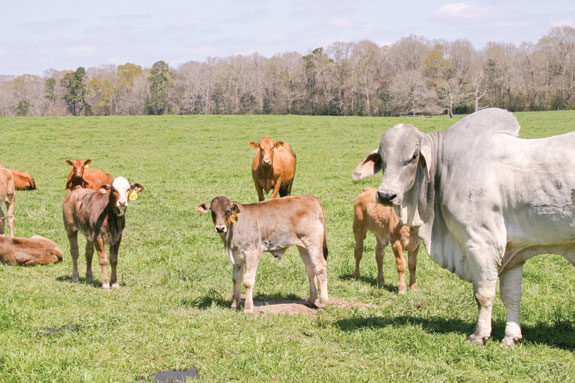With 2010 firmly behind us, it is time to look ahead to what the new year might bring.
There are many things on our minds this time of year as agriculture producers – keeping hay and feed in front of livestock, keeping water thawed and available, equipment maintenance, taxes and spring.
With spring approaching quickly, it is time to think about pastures and pasture management, and what to expect in terms of forage production this year.
Any forage outlook truly depends on where you farm or ranch. One must consider the differences in soil types and pasture types throughout the wide range of geographies in the United States.
For this article, let’s focus on the southern Great Plains region of the U.S. (although many of these principles can be applied nationwide).
Prognosticating about 2011 forage production not only depends on this year’s weather but also last year’s weather conditions and the pasture’s historic management practices.
This winter has been relatively mild and dry thus far for most producers in this region, and the long-range forecast indicates this trend will continue through the remainder of the winter and into the spring. Last year began with one of the most extreme winters the region experienced in decades.
Extreme wet and cold conditions weakened and thinned many bermudagrass and other introduced pasture stands. Although spring precipitation and temperatures were good for pasture growth and recovery, the moisture was short-lived for most producers, especially those in the eastern regions of Oklahoma and Texas as the drought conditions of the southeastern U.S. prevailed into the southern plains.
Overall, the weather during the last 12 to 18 months has had a negative influence on many pastures, with introduced pastures being most affected.
Management practices to ensure the overall health and production of forage pastures, or more specifically, the lack of appropriate management practices, have negatively impacted many pastures as well.
Due to the high cost of fertility and soil amendments in recent years, many introduced pastures and grazed forage cropland have received little or improper amounts of inputs to maintain productive stands.
If stocking rates have not been adjusted to more conservative numbers, these pastures are being maintained in an “overgrazed” state, which causes more stress on pastures. The extent to which pastures are overgrazed or mismanaged will directly correlate to the vigor and production of stands this spring.
Currently, forage reserves for the southern Great Plains are in relatively short supply with many pastures, both introduced and native, having been grazed closer (shorter) than considered desirable.
Hay reserves are limited in the eastern areas, with introduced pastures deficient in nutrients and grazed short being most at risk this coming growing season.
Surprisingly, much of the western portions of the southern Great Plains are in better overall condition. The western areas received average or greater precipitation this last growing season and appeared to have recovered from any adverse affects from the previous winter.
Pastures that have been well-maintained – appropriately grazed, fertilized and weed-sprayed where needed – are typically in good condition for this time of year.
Producers that have traditionally stocked more moderately or conservatively are well-positioned to have good forage conditions this spring.
Good to excellent condition native range pastures and introduced pastures that have been well-maintained and well-managed are in the most appropriate condition leading into this new year.
So what is to be expected this growing season? It depends. The long-range weather forecast for the southern Great Plains calls for the La Niña effect to remain through winter and spring (temperatures to be above average with below-average precipitation).
As forage producers, plan to apply your soil amendments early this spring to fully utilize what precipitation we do receive.
When planting forage crops or establishing perennial pasture, prepare well ahead of time and be ready to proceed when soil temperatures and moisture conditions are ideal. You will not want to be late with your management activities this spring.
Pasture weeds and crop pests could appear earlier than usual, so be prepared to scout pastures and crops early and more regularly this spring. Consider reducing stocking rates if pastures have been stressed or are in need of recovery, and initiate some rest and deferment where possible.
Monitor pastures closely beginning early in the year, making adjustments in management as needed to protect or enhance forage production.
For small grains pasture (specifically those used for grazing), topdress with nitrogen early this year at a moderate rate, and adjust the stocking rate to more conservative numbers to better match anticipated production.
If you intend to harvest small grains pasture in the southern Great Plains, remove grazing cattle earlier than usual, as first hollow-stem stage will probably occur early this year.
For perennial pasture, such as bermudagrass over-seeded with cool-season annuals like ryegrass, fertilize early this spring so annuals can be fully utilized by the time the perennial grasses start growing well.
Understand that the annuals will utilize most of the spring moisture, leaving little for early spring perennial grass production.
If your perennial grass stand needs recovery more than you need the early grazing, remove the annuals, applying an appropriate herbicide before the perennial grass initiates spring growth and before soil amendments are applied.
Native grass pastures (as well as introduced grass pastures) that have been grazed more severely than desired are candidates for weed-control measures early this spring. Weeds could emerge earlier than usual, so scout pastures early and often to determine if and when to apply herbicides.
For most weed species, we want to catch them when small to lessen the amount of product required to attain control. With the prospect of limited precipitation this growing season, we want to remove any unwanted competition for soil moisture and nutrients.
Again, adjust stocking rates to more conservative numbers if native pastures are showing signs of over-utilization or if annual precipitation continues to be below the long-term monthly average for your area.
How we approach the fall of 2011 will be determined by what occurs this spring and summer. Hopefully, the La Niña effect gripping the southern Great Plains will begin transitioning toward an El Niño weather pattern, but it is too early to speculate when that will happen.
For parts of the country experiencing cooler and/or wetter conditions than found in the southern Great Plains, management will have to adapt accordingly, but it is always best to be prepared ahead of time and be ready to proceed when conditions are right. Timing is usually critical to the success or failure (or the degree thereof) of a management practice.
Keep in mind that management is the most critical variable we control which determine the outcomes of our operations. You cannot manage what you do not monitor, and it is difficult to monitor what you do not measure and track over time.
Therefore, reflect back upon your historic weather patterns and your past management of your pastures; consider the long-range weather forecast for your area and the current conditions of your pastures; and develop a management strategy that reflects the needs and goals you have for your pastures. Remember: Prepare for the worst and you will never be disappointed.








